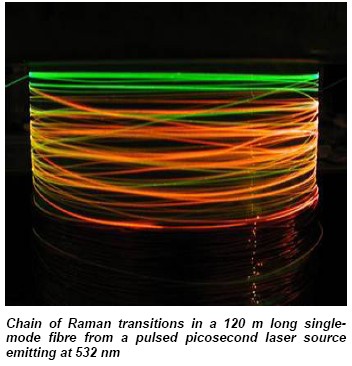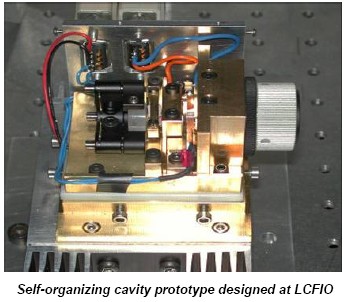

World Wide Welfare:
high BRIGHTness
semiconductor lasER for
gEneric Use
high BRIGHTness
semiconductor lasER for
gEneric Use
Partner 20 - Centre National de la Recherche Scientifique / Laboratoire Charles Fabry de l’Institut d’Optique
The Centre National de la Recherche Scientifique (CNRS, National Centre for Scientific Research) is a government-funded research organisation, under the administrative authority of France's Ministry of Research. Founded in 1939, the CNRS carries on its activities in all fields of knowledge from mathematics, high-energy physics, environmental sciences as well as humanities and social sciences. With 30,000 staff members, it is the largest fundamental EU research organisation. Its 1260 research units are spread throughout France.
The Laboratoire Charles Fabry de l'Institut d'Optique (LCFIO) is a joint laboratory partnered with the Institut d'Optique and the CNRS, in cooperation with the Université Paris-Sud. LCFIO is one major component of the Institut d’Optique together with the Engineering School, Ecole Supérieure d'Optique. Most faculty members of the School are active in research in the laboratory. Located on the premises of the University at Orsay, it enjoys a particularly active and rich scientific and technological environment in the Orsay / Saclay / Palaiseau area. LCFIO covers a broad range of optical research, both fundamental and applied, with emphasis on the experimental aspects. Skills covering essentially all of optics are highlighted by the timely research topics conducted by the six research groups:
- Atom Optics (Head: A. Aspect)
- Quantum Optics (Head: P. Grangier)
- Nanophotonics and Electromagnetism (Heads: H. Benisty and P. Lalanne)
- Lasers and Biophotonics (Heads: A. Brun and P. Georges)
- Non-Linear Materials and Applications (Heads: G. Roosen and G. Pauliat)
- Optical Components and Systems (Head: P. Chavel) LCFIO has about 100 staff members, including 50 PhD students and post-doctoral researchers.
The two research groups involved in the WWW.BRIGHT.EU project are the Non-Linear Materials and Applications group (Manolia) and the Lasers & Biophotonics group (LasBio):
- The expertise of Manolia in optical nonlinearities runs from fundamental physics of light matter interaction to the design and development of novel optical functions and components. Manolia is currently studying optical nonlinearities in nanostructured materials (photonic crystals and photonic crystal fibres) and epitaxial ferroelectric films. Taking advantage of specific nonlinearities evidenced in basic studies, Manolia designs and develops novel optical functions for telecommunications, holographic storage and for novel devices such as the self-organizing laser cavities developed within WWW.BRIGHT.EU.
- The Lasers and Biophotonics group study new organic and inorganic materials, and use them in optical systems, lasers, and biosensors for various applications. The group has strong partnerships with laser companies, from fundamental studies to the development of commercial products (for instance, the picosecond laser DualChip developed with Nanolase). In particular the group develops new solid-state laser sources from the continuous to the femtosecond regime. In a close collaboration with laboratories involved in the growth of new materials, this group studies various diodepumped solid-state gain media: crystals, fibres, and semiconductor structures. The association of these new materials with novel laser architectures, involving non-linear optical functions, allows one to design and investigate light sources with unprecedented characteristics. These activities trigger numerous applications in which the team is involved: biophotonics (fluorescence lifetime microscopy, eye surgery), metrology (optical frequency standards), solidstate physics (buried interface characterization, micromachining)
The Laboratoire Charles Fabry de l'Institut d'Optique (LCFIO) is a joint laboratory partnered with the Institut d'Optique and the CNRS, in cooperation with the Université Paris-Sud. LCFIO is one major component of the Institut d’Optique together with the Engineering School, Ecole Supérieure d'Optique. Most faculty members of the School are active in research in the laboratory. Located on the premises of the University at Orsay, it enjoys a particularly active and rich scientific and technological environment in the Orsay / Saclay / Palaiseau area. LCFIO covers a broad range of optical research, both fundamental and applied, with emphasis on the experimental aspects. Skills covering essentially all of optics are highlighted by the timely research topics conducted by the six research groups:
- Atom Optics (Head: A. Aspect)
- Quantum Optics (Head: P. Grangier)
- Nanophotonics and Electromagnetism (Heads: H. Benisty and P. Lalanne)
- Lasers and Biophotonics (Heads: A. Brun and P. Georges)
- Non-Linear Materials and Applications (Heads: G. Roosen and G. Pauliat)
- Optical Components and Systems (Head: P. Chavel) LCFIO has about 100 staff members, including 50 PhD students and post-doctoral researchers.
The two research groups involved in the WWW.BRIGHT.EU project are the Non-Linear Materials and Applications group (Manolia) and the Lasers & Biophotonics group (LasBio):
- The expertise of Manolia in optical nonlinearities runs from fundamental physics of light matter interaction to the design and development of novel optical functions and components. Manolia is currently studying optical nonlinearities in nanostructured materials (photonic crystals and photonic crystal fibres) and epitaxial ferroelectric films. Taking advantage of specific nonlinearities evidenced in basic studies, Manolia designs and develops novel optical functions for telecommunications, holographic storage and for novel devices such as the self-organizing laser cavities developed within WWW.BRIGHT.EU.
- The Lasers and Biophotonics group study new organic and inorganic materials, and use them in optical systems, lasers, and biosensors for various applications. The group has strong partnerships with laser companies, from fundamental studies to the development of commercial products (for instance, the picosecond laser DualChip developed with Nanolase). In particular the group develops new solid-state laser sources from the continuous to the femtosecond regime. In a close collaboration with laboratories involved in the growth of new materials, this group studies various diodepumped solid-state gain media: crystals, fibres, and semiconductor structures. The association of these new materials with novel laser architectures, involving non-linear optical functions, allows one to design and investigate light sources with unprecedented characteristics. These activities trigger numerous applications in which the team is involved: biophotonics (fluorescence lifetime microscopy, eye surgery), metrology (optical frequency standards), solidstate physics (buried interface characterization, micromachining)
Activities within WWW.BRIGHT-EU
In the scope of the WWW.BRIGHT.EU project, LCFIO takes part in developing novel externalcavity schemes for high-brightness, narrowlinewidth emission in WP3. Two designs have been investigated: self-organising laser cavities including a photorefractive crystal and wavelength-stabilized cavities with volume Bragg gratings. A self-organizing cavity is an extended cavity in which a dynamic holographic medium, e.g., a photorefractive crystal, is inserted. The modes oscillating inside the cavity record a dynamic hologram that acts as a spectral and spatial filter.
For a well-designed cavity, the result of this mutual interaction (i.e. modification of the hologram by the modes and vice-versa) leads to self-organization and thereby to an improvement of the spectral brightness of the laser with steady-state oscillation on a single longitudinal and transverse mode. The steady-state oscillation, being the result of a selforganization process, it is very robust to any cavity modifications: e.g. modifications originating during ageing, temperature or injection current changes, and slight cavity misalignments.
The photograph of a typical self-organized extended cavity developed within the WWW.BRIGHT.EU project is shown opposite. This cavity is built around a tapered device (either a device operating around 800 nm from the Ferdinand-Braun-Institute or a device operating at around 960 nm from the Fraunhofer IAF). Whatever the temperature and the injection current set within the operating range, the self-organization process always forces these devices to oscillate on a single longitudinal mode. Such laser sources have already shown their potential in some applications in which long coherence lengths are required with output powers ~ 1 W (typically interferometric applications, Optical Coherence Tomography, etc.).
On the other hand, volume Bragg gratings are essential components for either brightness improvement or spectrum stabilization in external cavities. Within the WWW.BRIGHT.EU project, we have taken advantage of the spectrally narrow reflectivity of Bragg gratings, with a high reflection and limited wavelength shift, for the stabilization of high-brightness semiconductor sources.
Tapered amplifiers in an external cavity including a Bragg grating have resulted in a high-power, good beam quality and narrow spectrum laser emission – an output power as high as 1.8 W, with a beam quality parameter M2 < 1.3 and a linewidth narrower than 80 pm has been obtained at 810 nm. This laser source has been utilised as the pump source for the single-pass extracavity second-harmonic generation towards 405 nm in a periodically-poled KTP crystal, in collaboration with Risø and Rainbow Photonics.
These promising results demonstrate the capabilities of extended-cavity laser diodes with Bragg gratings for non-linear conversion. The highbrightness and narrow linewidth of our extendedcavity tapered sources make them also suitable for the pumping of solid-state crystal lasers.
In the scope of the WWW.BRIGHT.EU project, LCFIO takes part in developing novel externalcavity schemes for high-brightness, narrowlinewidth emission in WP3. Two designs have been investigated: self-organising laser cavities including a photorefractive crystal and wavelength-stabilized cavities with volume Bragg gratings. A self-organizing cavity is an extended cavity in which a dynamic holographic medium, e.g., a photorefractive crystal, is inserted. The modes oscillating inside the cavity record a dynamic hologram that acts as a spectral and spatial filter.
For a well-designed cavity, the result of this mutual interaction (i.e. modification of the hologram by the modes and vice-versa) leads to self-organization and thereby to an improvement of the spectral brightness of the laser with steady-state oscillation on a single longitudinal and transverse mode. The steady-state oscillation, being the result of a selforganization process, it is very robust to any cavity modifications: e.g. modifications originating during ageing, temperature or injection current changes, and slight cavity misalignments.
The photograph of a typical self-organized extended cavity developed within the WWW.BRIGHT.EU project is shown opposite. This cavity is built around a tapered device (either a device operating around 800 nm from the Ferdinand-Braun-Institute or a device operating at around 960 nm from the Fraunhofer IAF). Whatever the temperature and the injection current set within the operating range, the self-organization process always forces these devices to oscillate on a single longitudinal mode. Such laser sources have already shown their potential in some applications in which long coherence lengths are required with output powers ~ 1 W (typically interferometric applications, Optical Coherence Tomography, etc.).
On the other hand, volume Bragg gratings are essential components for either brightness improvement or spectrum stabilization in external cavities. Within the WWW.BRIGHT.EU project, we have taken advantage of the spectrally narrow reflectivity of Bragg gratings, with a high reflection and limited wavelength shift, for the stabilization of high-brightness semiconductor sources.
Tapered amplifiers in an external cavity including a Bragg grating have resulted in a high-power, good beam quality and narrow spectrum laser emission – an output power as high as 1.8 W, with a beam quality parameter M2 < 1.3 and a linewidth narrower than 80 pm has been obtained at 810 nm. This laser source has been utilised as the pump source for the single-pass extracavity second-harmonic generation towards 405 nm in a periodically-poled KTP crystal, in collaboration with Risø and Rainbow Photonics.
These promising results demonstrate the capabilities of extended-cavity laser diodes with Bragg gratings for non-linear conversion. The highbrightness and narrow linewidth of our extendedcavity tapered sources make them also suitable for the pumping of solid-state crystal lasers.
For further information, please contact: Dr. Gilles Pauliat (gilles.pauliat@iota.u-psud.fr) for selforganized laser cavities and Dr. Gaëlle Lucas- Leclin (gaelle.lucas-leclin@iota.u-psud.fr) for fixed grating extended-cavities. More information on CNRS and LCFIO can be found at www.cnrs.fr and www.institutoptique.fr


[Home] [Project] [Participants] [Newsletters] [Publications] [Workshops] [Tutorials] [More...] [Private] [Legal notice]
